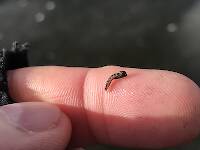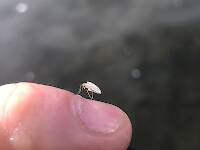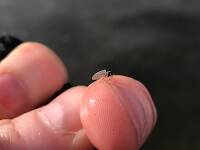
Hex Mayflies
Hexagenia limbata
The famous nocturnal Hex hatch of the Midwest (and a few other lucky locations) stirs to the surface mythically large brown trout that only touch streamers for the rest of the year.
Featured on the forum

This one pretty clearly keys to Kogotus, but it also looks fairly different from specimens I caught in the same creek about a month later in the year. With only one species of the genus known in Washington, I'm not sure about the answer to this ID.

Troutnut is a project started in 2003 by salmonid ecologist Jason "Troutnut" Neuswanger to help anglers and
fly tyers unabashedly embrace the entomological side of the sport. Learn more about Troutnut or
support the project for an enhanced experience here.
Taxon on Feb 20, 2010February 20th, 2010, 8:05 am EST
Darrin-
Not a midge (family Chironomidae); appears to be a black fly (family Simuliidae).
Not a midge (family Chironomidae); appears to be a black fly (family Simuliidae).
Dossphoto on Feb 20, 2010February 20th, 2010, 12:03 pm EST
Thanks!
I had always thought of black flies as being a warmer weather fly. I wasn't really expecting them this time of year. Although that does explain why the fish were ignoring my black midge patterns.
I had always thought of black flies as being a warmer weather fly. I wasn't really expecting them this time of year. Although that does explain why the fish were ignoring my black midge patterns.
Gutcutter on Feb 21, 2010February 21st, 2010, 11:38 am EST
if the fish were rising to these "blackflies" and you had a fly of the same size, general shape and shade(+/-) then they should have taken your offering as long as it was presented well.
a trout does not know latin the way some of us do. they will eat what is available.
maybe taxon can tell us if there are differences in how a midge emerges vs a blackfly.
i am wondering if these bugs are related to the african blackfly (also simuliidae) that are the vector for river blindness (Onchocerca volvulus). i learned some latin, too as a research student studying parasitology.
also are these related to the horrific bahamian bug that bears the same common name? a bonefish guide once responded to my question of "what kind of insects are they" as "dey bitey bugs mon"
gut
a trout does not know latin the way some of us do. they will eat what is available.
maybe taxon can tell us if there are differences in how a midge emerges vs a blackfly.
i am wondering if these bugs are related to the african blackfly (also simuliidae) that are the vector for river blindness (Onchocerca volvulus). i learned some latin, too as a research student studying parasitology.
also are these related to the horrific bahamian bug that bears the same common name? a bonefish guide once responded to my question of "what kind of insects are they" as "dey bitey bugs mon"
gut
All men who fish may in turn be divided into two parts: those who fish for trout and those who don't. Trout fishermen are a race apart: they are a dedicated crew- indolent, improvident, and quietly mad.
-Robert Traver, Trout Madness
-Robert Traver, Trout Madness
Taxon on Feb 21, 2010February 21st, 2010, 3:09 pm EST
Tony-
Don't have any experience with fishing to emerging black flies, but would observe they have a different profile that a chironomid, as they are much wider for their length. My suspicion would be that, much like chironomids, their pupal lifestage would be the one more successfully imitated by a fly fisher.
Don't have any experience with fishing to emerging black flies, but would observe they have a different profile that a chironomid, as they are much wider for their length. My suspicion would be that, much like chironomids, their pupal lifestage would be the one more successfully imitated by a fly fisher.
Wbranch on Feb 22, 2010February 22nd, 2010, 10:31 pm EST
"a trout does not know latin the way some of us do. they will eat what is available."
I agree with Mr. Cutter, if your black midge pattern was similar in size and shape to the emering insect, and you presented the fly properly, in most cases the fish would eat your offering.
I agree with Mr. Cutter, if your black midge pattern was similar in size and shape to the emering insect, and you presented the fly properly, in most cases the fish would eat your offering.
Catskill fly fisher for fifty-five years.
Quick Reply
Related Discussions
Topic
Replies
Last Reply
Re: Identification of a possible Cordulegaster Dragonfly Nymph
In Cordulegaster Dragonfly Nymph by IanB
In Cordulegaster Dragonfly Nymph by IanB
6
Feb 10, 2017
by Taxon
by Taxon








